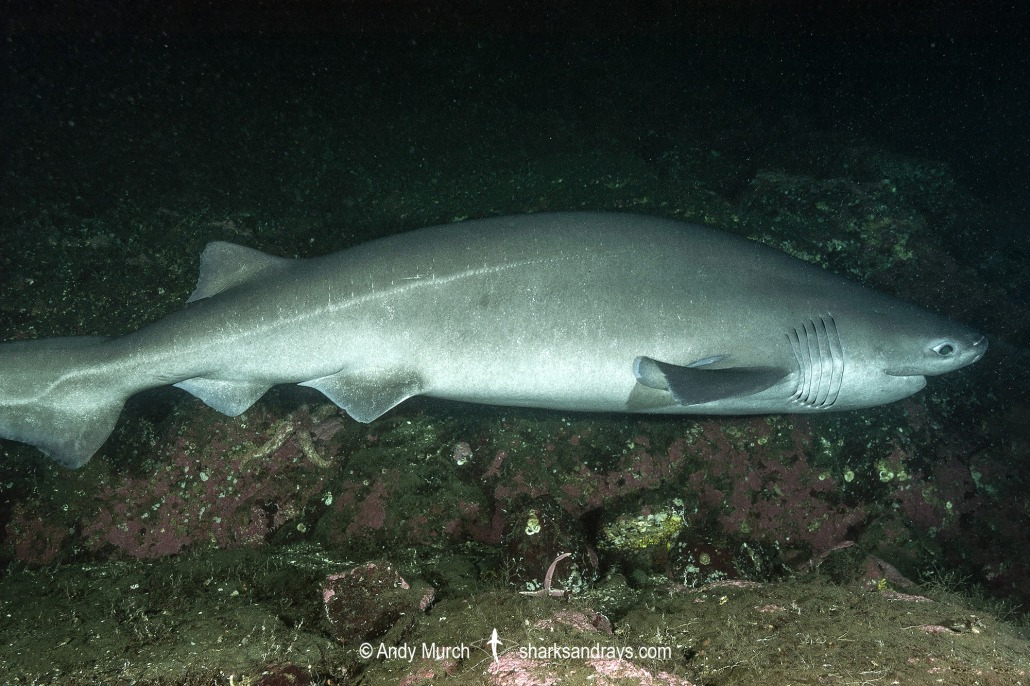Bluntnose sixgill shark
Scientific Name: Hexanchus griseus (Bonnaterre, 1788)
Authors: Christian and Elijah
Photo: Thank you to Andy Murch for the use of his photo.
Identifying features: Unlike the typical 5 gill slits of some sharks this fish has 6 long pairs of gill slits. The gill slits get shorter the farther away they are from the head. Their back is shaped in a somewhat hunched manner, with their dorsal fin far back over the posterior part of the pelvic fins. Pectoral fins are largely wide compared to their moderate length. Their caudal fins has an upper lobe that is very long compared to the shorter lower lobe. Their body shape is unique – they have a wide, rounded head with relatively large fluorescent green eyes, and a massive (up to 15 ft long) dark brown, grey, or black body.

Habitat: They can be found in deep habitats all around the world, yet they can be quite commonly found in local Pacific Northwest waters, such as Hornby Island. They are mainly found on continental shelves, insular shelves, and slopes at depths ranging from 0 to 2,500m (8,200 ft) below sea level. Juveniles normally inhabit more shallow waters compared to adults. (De Maddalena et al., 2007, 85)
Local Diving Spots: Hornby Island and Flora Islet in the Strait of Georgia, British Columbia, is a known diving hotspot for finding these sharks in the region. The best time to see them here is during the warmer summer months, especially during the afternoons of the hottest times of the year, mid-June and mid-July. Recommended depth for sitings is 18-30 M (60-100 ft) below sea level. They have also been encountered off of Saanich Inlet and Barkley Sound while diving. (De Maddalena et al., 2007, 85)
Prey: They seem to eat a mix of fishes, such as other local sharks, rays, cephalopods, sea urchins, or dead carcasses. Pretty much anything that they can fit in their mouth. They hunt via ambush but also scavenge for food. They have only been observed to hunt solitarily, yet at extreme depths, they can be seen eating large whale carcasses – a very prized meal.
Predators: Certain sea mammals may prey on these sharks in shallow waters, such as Steller’s sea lions, or orca. Great White Sharks are also know as a predator of these slow moving sharks.
Life Cycle: These fish are born live out of the womb in litters of 22 all the way up to 108. As of 2023, it is not fully confirmed how long they live for, but it is likely that they live up to 80 years, and reach maturity around 11-14 for males and 18 – 35 for females.
Fun Facts:
- largest member of the Cow sharks
- They have been known to attack submarines (BBC News, 2017)
- They are suction feeders.
- Not hostile towards humans, represent little threat. (Bester, 2023)
- Their earliest ancestors date back to over 200 million years.
- They are slow moving yet powerful ambushers. (Bester, 2023)
- Unlike other sharks, they are not born out of an egg. (Bester, 2023)
References
BBC News. (2017, November 9). https://www.youtube.com/watch?v=ZqBfyocxqr4&t=110s. YouTube. Retrieved January 25, 2024, from https://www.youtube.com/watch?time_continue=110&v=ZqBfyocxqr4&embeds_referring_euri=https%3A%2F%2Ffactanimal.com%2F&source_ve_path=MjM4NTE&feature=emb_title
Bester, C. (2023, December 28). Hexanchus griseus – Discover Fishes. Florida Museum. Retrieved January 25, 2024, from http://floridamuseum.ufl.edu/discover-fish/species-profiles/hexanchus-griseus/
De Maddalena, A., Preti, A., & Polansky, T. (2007). Sharks of the Pacific Northwest: Including Oregon, Washington, British Columbia and Alaska. Harbour Pub.
Hart, J. L. (1973). Pacific fishes of Canada. Fisheries Research Board of Canada.

